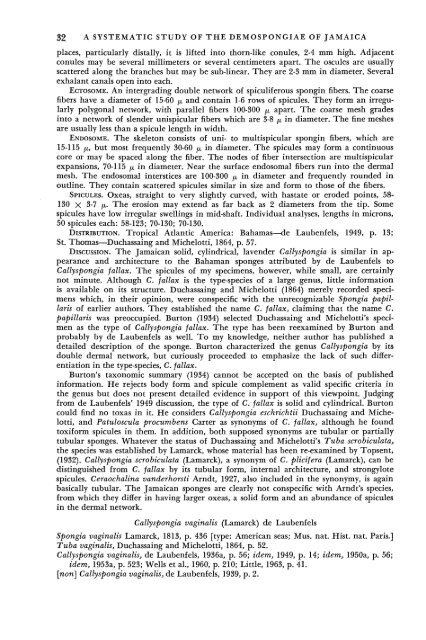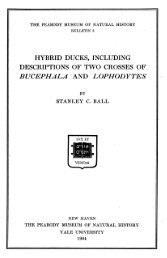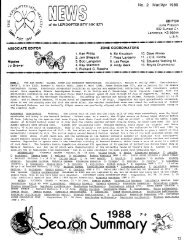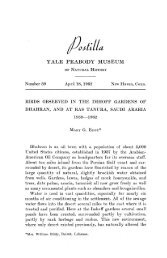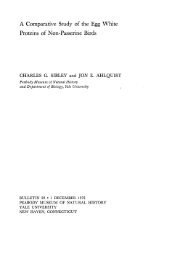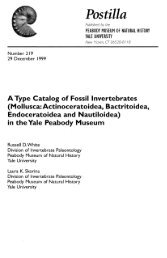Bulletin 20 - Peabody Museum of Natural History - Yale University
Bulletin 20 - Peabody Museum of Natural History - Yale University
Bulletin 20 - Peabody Museum of Natural History - Yale University
You also want an ePaper? Increase the reach of your titles
YUMPU automatically turns print PDFs into web optimized ePapers that Google loves.
32 A SYSTEMATIC STUDY OF THE DEMOSPONGIAE OF JAMAICA<br />
places, particularly distally, it is lifted into thorn-like conules, 2-4 mm high. Adjacent<br />
conules may be several millimeters or several centimeters apart. The oscules are usually<br />
scattered along the branches but may be sub-linear. They are 2-3 mm in diameter. Several<br />
exhalant canals open into each.<br />
ECTOSOME. An intergrading double network <strong>of</strong> spiculiferous spongin fibers. The coarse<br />
fibers have a diameter <strong>of</strong> 15-60 ju and contain 1-6 rows <strong>of</strong> spicules. They form an irregularly<br />
polygonal network, with parallel fibers 100-300 /x apart. The coarse mesh grades<br />
into a network <strong>of</strong> slender unispicular fibers which are 3-8 ^ in diameter. The fine meshes<br />
are usually less than a spicule length in width.<br />
ENDOSOME. The skeleton consists <strong>of</strong> uni- to multispicular spongin fibers, which are<br />
15-115 [A, but most frequently 30-60 JJL in diameter. The spicules may form a continuous<br />
core or may be spaced along the fiber. The nodes <strong>of</strong> fiber intersection are multispicular<br />
expansions, 70-115 ^ in diameter. Near the surface endosomal fibers run into the dermal<br />
mesh. The endosomal interstices are 100-300 fx in diameter and frequently rounded in<br />
outline. They contain scattered spicules similar in size and form to those <strong>of</strong> the fibers.<br />
SPICULES. Oxeas, straight to very slightly curved, with hastate or eroded points, 58-<br />
130 X 3-7 /A. The erosion may extend as far back as 2 diameters from the tip. Some<br />
spicules have low irregular swellings in mid-shaft. Individual analyses, lengths in microns,<br />
50 spicules each: 58-123; 70-130; 70-130.<br />
DISTRIBUTION. Tropical Atlantic America: Bahamas—de Laubenfels, 1949, p. 13;<br />
St. Thomas—Duchassaing and Michelotti, 1864, p. 57.<br />
DISCUSSION. The Jamaican solid, cylindrical, lavender Callyspongia is similar in appearance<br />
and architecture to the Bahaman sponges attributed by de Laubenfels to<br />
Callyspongia fallax. The spicules <strong>of</strong> my specimens, however, while small, are certainly<br />
not minute. Although C. fallax is the type-species <strong>of</strong> a large genus, little information<br />
is available on its structure. Duchassaing and Michelotti (1864) merely recorded specimens<br />
which, in their opinion, were conspecific with the unrecognizable Spongia papillaris<br />
<strong>of</strong> earlier authors. They established the name C. fallax, claiming that the name C.<br />
papillaris was preoccupied. Burton (1934) selected Duchassaing and Michelotti's specimen<br />
as the type <strong>of</strong> Callyspongia fallax. The type has been reexamined by Burton and<br />
probably by de Laubenfels as well. To my knowledge, neither author has published a<br />
detailed description <strong>of</strong> the sponge. Burton characterized the genus Callyspongia by its<br />
double dermal network, but curiously proceeded to emphasize the lack <strong>of</strong> such differentiation<br />
in the type-species, C. fallax.<br />
Burton's taxonomic summary (1934) cannot be accepted on the basis <strong>of</strong> published<br />
information. He rejects body form and spicule complement as valid specific criteria in<br />
the genus but does not present detailed evidence in support <strong>of</strong> this viewpoint. Judging<br />
from de Laubenfels' 1949 discussion, the type <strong>of</strong> C. fallax is solid and cylindrical. Burton<br />
could find no toxas in it. He considers Callyspongia eschrichtii Duchassaing and Michelotti,<br />
and Patuloscula procumbens Carter as synonyms <strong>of</strong> C. fallax, although he found<br />
toxiform spicules in them. In addition, both supposed synonyms are tubular or partially<br />
tubular sponges. Whatever the status <strong>of</strong> Duchassaing and Michelotti's Tuba scrobiculata,<br />
the species was established by Lamarck, whose material has been re-examined by Topsent,<br />
(1932). Callyspongia scrobiculata (Lamarck), a synonym <strong>of</strong> C. plicifera (Lamarck), can be<br />
distinguished from C. fallax by its tubular form, internal architecture, and strongylote<br />
spicules. Ceraochalina vanderhorsti Arndt, 1927, also included in the synonymy, is again<br />
basically tubular. The Jamaican sponges are clearly not conspecific with Arndt's species,<br />
from which they differ in having larger oxeas, a solid form and an abundance <strong>of</strong> spicules<br />
in the dermal network.<br />
Callyspongia vaginalis (Lamarck) de Laubenfels<br />
Spongia vaginalis Lamarck, 1813, p. 436 [type: American seas; Mus. nat. Hist. nat. Paris.]<br />
Tuba vaginalis, Duchassaing and Michelotti, 1864, p. 52.<br />
Callyspongia vaginalis, de Laubenfels, 1936a, p. 56; idem, 1949, p. 14; idem, 1950a, p. 56;<br />
idem, 1953a, p. 523; Wells et al., 1960, p. 210; Little, 1963, p. 41.<br />
[non] Callyspongia vaginalis, de Laubenfels, 1939, p. 2.


